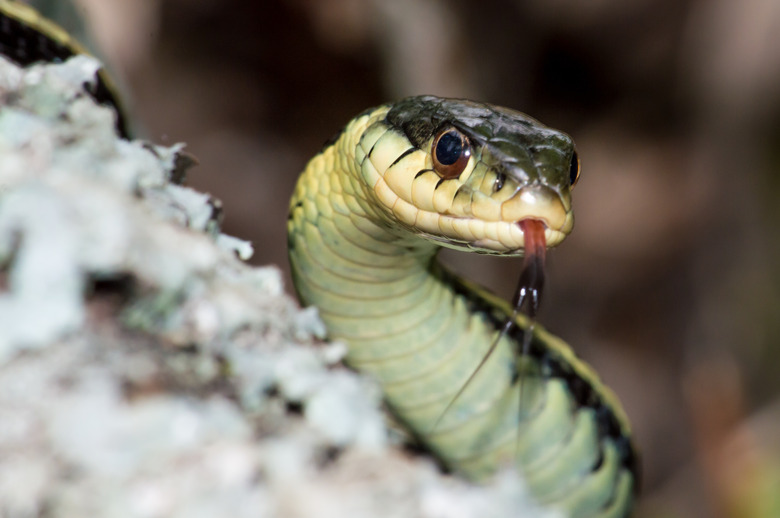How To Identify Snakes In Pennsylvania
Pennsylvania is a Middle Atlantic U.S. state known for its historical significance. In addition to being the home of attractions such as the Liberty Bell and Congress Hall, Pennsylvania is home to more than 21 species of snakes. Knowing how to identify snakes can be important for someone living or planning to spend time in Pennsylvania because three of these species are venomous and can become dangerous when approached. Look at a snake's markings, size and shape for clues about a snake's species.
TL;DR (Too Long; Didn't Read)
There are more than 21 species of snakes in Pennsylvania including three venomous species. Looking at the size, shape and markings of a snake can help you identify its species.
Shorthead Garter Snake
Shorthead Garter Snake
Many species of garter snakes are native to Pennsylvania. One of the most common and distinct-looking is the shorthead garter snake. These small, nonvenomous snakes are found mostly in the northwestern part of Pennsylvania near bodies of water in forested areas. They are easy to identify thanks to their distinct markings. The brown bodies of shorthead garter snakes are covered in bold, vertical, yellowish stripes that make them recognizable even from a distance.
Like most garter snakes, shorthead garters never grow to more than 2 feet in length. Their heads and bodies are thin. It is important to remember these types of details when identifying snakes, as markings between species can sometimes be similar. Shorthead garter snakes are not the only striped snakes native to Pennsylvania, but they are one of the smallest and most uniquely colored.
Northern Copperhead
Northern Copperhead
Found in forests and rocky areas, the northern copperhead is one of three venomous snake species native to Pennsylvania. These relatively large snakes can reach lengths of 2 to 3 feet. Because these snakes are venomous, knowing how to recognize them is extremely important for anyone who plans to spend time in Pennsylvania.
Northern copperheads are long, full-bodied snakes with triangular heads that are wide in the back and come to a point at the snout. As their name suggests, their bodies are usually copper and covered in rusty brown bands, outlined in dark brown with dark brown spots between each band.
If you encounter a northern copperhead in the wild, exercise caution. These snakes can be aggressive when they feel threatened and may exhibit behaviors such as puffing up their bodies, bobbing their heads and hissing loudly. In this situation, back away quickly. If you are bitten by a northern copperhead, seek medical attention immediately, as treatment requires a dose of anti-venom.
Eastern Milk Snake
Eastern Milk Snake
Eastern milk snakes are not venomous, but they are often confused for venomous copperheads. This is likely because the snakes share a similar coloration. The eastern milk snake is light brown, with rust-colored bands surrounded by dark brown borders running down its body. It even has dark brown spots in between its bands, just like a northern copperhead.
However, there are some key differences in appearance between northern copperheads and eastern milk snakes:
- Eastern milk snakes can be lighter in color than copperheads. Copperheads are always copper, while eastern milk snakes range in color from copper to light, sandy brown.
- Eastern milk snakes grow longer than northern copperheads. While copperheads can reach an adult length of 3 feet, eastern milk snakes can grow to be more than 4 feet long.
- Eastern milk snakes have slim heads, rather than triangular heads.
- Eastern milk snakes are much more populous than northern copperheads. Northern copperheads have grown scarce enough in Pennsylvania that they are considered a species of special concern, which is a similar classification to threatened or endangered.
If you encounter a copper-colored Pennsylvanian snake with rust-colored bands, it is probably an eastern milk snake and not a venomous northern copperhead. However, it is best to keep your distance, just in case.
Timber Rattlesnake
Timber Rattlesnake
Rattlesnakes are some of the most famous snakes in the world due to the distinctive rattling sound they make when threatened. There are 32 rattlesnake species in the world, but only one is native to Pennsylvania: the timber rattlesnake.
Like all rattlesnakes, timber rattlesnakes can use the tips of their tails to create a loud rattling sound when they are startled. This is fortunate because timber rattlesnakes often hide under logs or rocky outcroppings where humans and other animals may stumble upon them. The timber rattlesnake's rattle is a warning to stay away and may give a would-be snakebite victim time to escape. The tip of a timber rattlesnake's tail consists of segments of loosely fitting keratin that knock against one another when waved back and forth. This produces the snake's famous sound.
There are other ways to identify a timber rattlesnake besides its rattle. These snakes are normally light gray, with dark brown bands or splotches. They have thick bodies and large, triangular heads. Timber rattlesnakes are fairly long, growing to an adult size of 3 to 5 feet.
If you encounter a timber rattlesnake in the wild, keep your distance. If you are bitten by a timber rattlesnake, seek medical attention immediately, as treatment requires a dose of anti-venom.
Learning to identify snakes in your area, whether you live in Pennsylvania or elsewhere, can be fun and may even serve as an important safety measure.
Cite This Article
MLA
Cook, Maria. "How To Identify Snakes In Pennsylvania" sciencing.com, https://www.sciencing.com/identify-snakes-pennsylvania-4884549/. 11 April 2018.
APA
Cook, Maria. (2018, April 11). How To Identify Snakes In Pennsylvania. sciencing.com. Retrieved from https://www.sciencing.com/identify-snakes-pennsylvania-4884549/
Chicago
Cook, Maria. How To Identify Snakes In Pennsylvania last modified March 24, 2022. https://www.sciencing.com/identify-snakes-pennsylvania-4884549/
